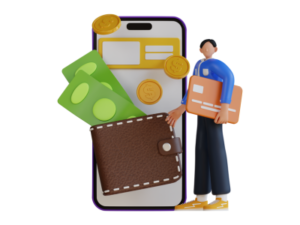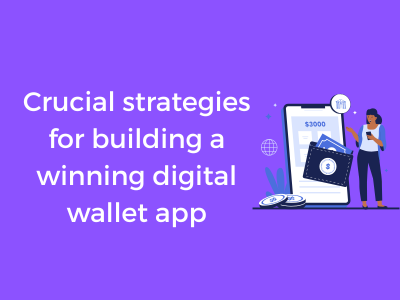So, you’re thinking about building a digital wallet app? That’s a fantastic idea! But before diving into development, let’s start with the basics: establishing a rock-solid foundation. A digital wallet isn’t just another app; it’s a highly functional tool that users will rely on for their financial transactions. To ensure your app wins user trust and stands out, you’ll need to include some crucial features. Let’s explore them together!
Prioritizing Security: Safeguarding Data and Transactions at Every Step
Look, we all love the convenience of digital wallets—they make paying for your morning coffee or sending cash to friends incredibly easy. But here’s the thing: no one’s going to trust—or even use—your digital wallet if they feel their money or private information isn’t secure. Security is king in the digital world, and when it comes to handling someone’s finances, there’s no room for error. Let’s break down exactly how you can prioritize security every step of the way.
The Basics: Start with Strong Authentication
Think of authentication as the front door to your app. Would you want a flimsy lock guarding the treasures inside? Absolutely not. This is why implementing multi-factor authentication (MFA) is a must. At the very least, your app should require a combination of something the user knows (a password or PIN), something they have (like their smartphone), or something they are (biometric options like facial recognition or fingerprints).
Remember to also enforce strong password policies—require a mix of uppercase, lowercase, numbers, and symbols. And if you’re really ahead of the game, consider passkeys (passwordless authentication). Bonus: this not only secures accounts but makes life easier for your users!
Encrypt Everything
If there’s one word to burn into your brain, it’s encryption. Data encryption is the digital wallet industry’s bulletproof vest. From a user’s account details to transaction data, ensure you’re encrypting everything—whether it’s in transit or at rest. Using industry gold standards like AES-256 encryption ensures that even if data somehow gets intercepted, it’s useless to cybercriminals.
Secure Transactions Like a Pro
Transactions are the heartbeat of a digital wallet app. You need to treat handling them like running a high-security vault. Incorporate secure and proven protocols like Tokenization, which replaces sensitive information with unique tokens. This makes sure that even if there’s a breach, the raw data (like credit card numbers) is inaccessible.
Use 3D Secure Protocols for extra layers of verification during transactions. These require users to authenticate the payment with an additional step, like a one-time password (OTP) sent via text. It might seem like a hassle, but remember that peace of mind is priceless for your users.
Monitor, Alert, Protect
Cyberattacks are constantly evolving—even the most secure systems can come under threat. This is why it’s crucial to have a robust monitoring system in place to track suspicious activity in real-time.
- Set up behavioral analytics to recognize unusual patterns—like a login attempt from an unfamiliar location or rapid transactions from a new device.
- Send instant alerts to users when suspicious activities occur. For example: “We noticed a new login from [location]. Was this you?”
- Introduce a freeze feature that allows users to temporarily suspend their accounts in case they suspect fraud.
Stay Compliant
Governments and financial authorities across the world have set up data protection laws (like GDPR or PCI DSS). While they might feel like extra red tape, they actually provide a wonderful set of guidelines to follow for locking down your app’s security. Plus, staying compliant builds trust—users will feel more comfortable knowing you’re playing by the rules.
Regular Security Audits and Updates
Your job isn’t finished once your app launches. Hackers certainly don’t rest, so you can’t either! Schedule frequent security audits to identify potential vulnerabilities. Additionally, roll out updates and patches promptly to address any newly identified gaps. Communicating these updates transparently with your users is also a great way to keep them assured of your commitment to their safety.

Seamless User Experience: Making Transactions Smooth and Effortless
In today’s fast-paced digital world, the last thing users want is a clunky, confusing, or frustrating app experience. When it comes to digital wallets, ensuring a seamless user experience (UX) isn’t just a ‘nice-to-have’—it’s absolutely essential. Think about it: the primary goal of any digital wallet app is to simplify transactions. So, let’s discuss how designers and developers can make sure their app delivers smooth and effortless usability from start to finish.
1. Keep the Interface Clean and Intuitive
An overly complicated interface can quickly put users off. From the moment a user opens your app, they should immediately understand how to navigate it. Complex menus, hidden options, or an overload of information can be overwhelming.
- Simplicity is key: Limit the number of taps needed to accomplish a task like transferring money or checking the balance.
- Visual hierarchy: Use smart design principles to guide users’ attention to the most important actions, such as the “Pay Now” or “Add Money” buttons.
2. Swift and Reliable Transactions
The backbone of any great digital wallet is its ability to make transactions fast and reliable. No one wants to be left waiting or wondering whether their transaction went through. Delays or errors in payment processing are some of the surest ways to lose user trust.
- Work on optimizing app performance to ensure speedy processing times.
- Offer users real-time status updates—such as confirmation notifications—to eliminate any uncertainty.
- Have a failsafe mechanism that allows users to retry failed transactions effortlessly.
3. Simple Onboarding Process
First impressions matter a lot. The onboarding experience can set the tone for how users perceive your digital wallet. A seamless registration and initial setup process are critical to retaining users from the very start.
- Social (or email) login options: Don’t make users remember yet another password.
- Minimal data entry: Only ask for the information you need, and explain why it’s needed.
- Interactive tutorials: Use guided tours or tooltips to familiarize users with your app’s functions.
4. Frictionless Integration with Everyday Life
For a truly effortless user experience, your app needs to fit seamlessly into users’ daily routines. Consider adding features like:
- Recurring payments: Allow users to automate bill payments directly from the app.
- Quick QR code scanning: Make peer-to-peer payments nearly instant with a no-hassle scanning feature.
- Offline support: Enable limited functionality when there’s no internet—this can be a lifesaver.
5. Accessibility for All
A seamless experience means leaving no one behind. Pay attention to accessibility by ensuring your app is usable for people with disabilities.
- Provide screen reader compatibility for visually impaired users.
- Use clear fonts, buttons, and high-contrast design for improved readability.
- Include multilingual support to cater to a global audience.
Smart Integrations: Balancing Payment Options and Third-Party Collaboration
If you’re diving into the development of a digital wallet app, let’s talk about one of the most fascinating and dynamic aspects: smart integrations. Simply put, it’s the art of harmonizing diverse payment options and leveraging third-party collaborations to create a one-stop solution for your users. Sounds exciting, doesn’t it? Let’s explore how to master this balance while keeping things practical and user-friendly.
Why Are Smart Integrations So Important?
Think about it – no one wants a limited wallet. Users want flexibility, and the ability to connect with their preferred payment methods is non-negotiable. Whether it’s linking to traditional bank accounts, credit cards, PayPal, cryptocurrency wallets, or newer “buy now, pay later” services, your app’s value increases with every integration.
But there’s a fine line. Adding too many options without proper optimization can overwhelm your users and complicate app maintenance. The trick is finding that “golden balance” between offering choice and maintaining simplicity.
Start with a Variety of Payment Options
One core must-have for your digital wallet app is diverse and seamless payment options. Here’s what you should consider offering:
- Bank Account Integrations: Enable users to link their primary or secondary banking accounts effortlessly. Partnerships with major bank networks make this integration smooth and reliable.
- Mobile Payment Systems: Services like Google Pay, Apple Pay, and Samsung Pay are table stakes in the modern payment game. Incorporate them to meet tech-savvy user expectations.
- Cryptocurrency Wallets: With the rise of digital currencies, integrating popular crypto-wallets like Coinbase or MetaMask can tap into a growing market.
- International Payments: Embrace multi-currency wallets to serve businesses and users who need cross-border functionality.
Think of your digital wallet as a buffet: cater to all tastes, but keep it organized and appealing!
Collaborate with the Right Third-Party Providers
Did you know that third-party collaborations can be the secret sauce of your app’s success? By partnering with API providers, you streamline critical functionalities, reduce development workload, and unlock new features.
Here are some smart partnership ideas:
- Payment Processors: Collaborate with trusted names like Stripe, Square, or Adyen to handle transactions securely and efficiently.
- Loyalty and Rewards Platforms: Tie up with services that allow users to earn and redeem rewards, adding more incentives to use your wallet.
- Retail Relationships: Integrate directly with e-commerce platforms or retailers to make in-app purchases or checkout processes a breeze.
APIs and SDKs: Your Technical Best Friends
Application Programming Interfaces (APIs) and Software Development Kits (SDKs) are the backbone of integrations. When choosing API partners, prioritize ease of integration, robust documentation, and strong customer support. This ensures your development team can quickly bridge features without headaches or hiccups.
Keeping It User-Centric
Remember, integrations are only as effective as the experience they provide. Put yourself in your user’s shoes. Would you want convoluted sign-ups for connecting multiple services? Of course not! Keep the process intuitive, with easy-to-follow steps and helpful guidance. Progress indicators and confirmations are simple touches that increase user confidence.
The Role of Personalization: Catering to User Preferences Effectively
Let’s talk about personalization! In today’s digital era, users expect services tailored to their unique preferences, and digital wallet apps are no exception. Personalization is not merely a fancy feature; it’s an essential ingredient for building user loyalty and boosting engagement. Let’s dive into how you can harness the power of personalization to cater to your users’ needs effectively.
The Importance of Knowing Your Users
The first step in building a personalized experience is understanding your users. What do they value most in a digital wallet? Is it quick payments, bill reminders, or rewards tracking? Dive into user analytics to discover patterns in their behavior. By identifying preferences, such as the type of transactions they frequently make or their preferred payment methods, you can design features that truly resonate with their needs.
Consider integrating options to customize the app’s appearance, like selecting themes or layouts. Something as simple as letting users pick their favorite colors for the app UI can go a long way in building a connection with them!
Customized Notifications and Alerts
Have you ever received a notification that felt irrelevant or spammy? Nothing shuts down user interest faster. The key here is relevance. For a digital wallet app, push notifications can be tailored to specific user actions and preferences. For example:
- Send reminders for upcoming bill payments or subscription renewals.
- Notify users about cashback offers on brands they frequently shop at.
- Provide updates on loyalty points or rewards they’ve earned.
These well-timed, personalized notifications can feel helpful rather than annoying. Just ensure users have easy control to opt-in or customize their notification preferences—respect for their choices builds trust!
Personalized Recommendations
Another fun way to show users you’re paying attention is by offering personalized recommendations. For instance:
- Suggest services to add to their account based on spending habits, like linking specific loyalty programs.
- Recommend budgeting tools if you notice they make frequent small transactions, hinting they may want to track spending patterns.
- Highlight features they haven’t tried yet—perhaps a secure split-payment tool for group transactions.
Using AI or machine learning can help refine these recommendations over time, making them even more valuable and accurate.
Localization is Key
If your digital wallet app has a global audience, remember that personalization also includes localization. Providing content, payment options, or even language preferences tailored to the user’s region can make them feel right at home using your app. For instance, offering festive discounts during local holidays or enabling transactions in the user’s preferred currency boosts usability and delight.
Maintain a Fine Balance
A word of caution—while personalization is powerful, overdoing it can feel invasive. Strike a balance that respects users’ privacy while offering relevant, bespoke services. Always give transparent explanations about how their data is used and offer opt-in options before implementing any form of personalization.
Testing and Feedback: How Continuous Improvement Leads to Success
Building a digital wallet app is no small task, but one of the most overlooked aspects of this entire journey is the power of testing and embracing user feedback. Let’s face it: even the brightest ideas can tumble without the right refinements. So, how do you ensure your app isn’t just good, but a champion in its space? The answer lies in the cycle of continuous improvement.
Why Testing is a Non-Negotiable Step
Imagine launching your digital wallet app, only to find out users are stuck on basic processes. That would hurt, right? This is where rigorous testing steps in. Whether it’s through alpha, beta, or even stress testing, it’s crucial to evaluate how your app performs under various conditions before it makes its big debut.
- Alpha Testing: Performed by your in-house team. The aim here is to catch bugs early and ensure that basic functionality works seamlessly.
- Beta Testing: This puts the app into the hands of real users. Feedback from this stage is a treasure—users will spot things your team might have overlooked.
- Automation Testing: Don’t forget automated tests! These can efficiently identify repetitive issues like payment gateway glitches or errors in transaction records.
The more testing layers you add, the higher your chances of delivering a polished app right from day one.
User Feedback: Your Golden Opportunity
Here’s a tip: users are your best critics. Once your app is alive in the real world, it’s vital to actively seek and analyze user feedback because—guess what?—people will tell you exactly what they love or hate about your app.
Some ways to collect feedback include:
- In-app Surveys: Make quick surveys available. Prompt users to provide feedback after completing key actions, like their first transaction.
- App Store Reviews: Monitor comments and ratings on app stores. They give a snapshot of public sentiment.
- Customer Support Engagement: Attend to queries and pay attention to recurring problems. Dissatisfied users are often the loudest, but addressing their concerns can turn situations around.
Remember, feedback isn’t just about fixing issues—it’s about finding opportunities. Users might suggest new features, better interfaces, or missing functionalities, helping you take your app to the next level.
The Virtuous Cycle of Continuous Improvement
Here’s a pro tip for long-term success: treat your digital wallet app as a living, evolving product, not a one-and-done project. How do you do this?
- Monitor Analytics Constantly: Keep an eye on usage data. Are features underperforming or unused? This could be a sign to revise or remove them.
- Prioritize Updates: Regularly roll out updates with fixes and enhancements. Let users know you’re listening to their needs.
- A/B Testing: Experiment with different designs or flows to identify what resonates best with users.
Continuous improvement isn’t a chore; it’s a mindset. Apps that thrive are the ones that adapt. Just think of the success stories like PayPal or Apple Pay—they didn’t get it all perfect from the start, but they kept tweaking, learning, and growing.
Marketing Strategies: Gaining Users and Building Trust in a Competitive Space
So, you’ve built an amazing digital wallet app, packed with essential features, stellar security measures, and a killer user experience. Now what? To make sure your app doesn’t get lost in the noise of today’s crowded fintech marketplace, it’s time to craft and execute a winning marketing strategy. Let’s talk about how to attract users and, most importantly, build their trust.

Understand Your Target Audience
Your digital wallet app can’t be everything to everyone—and that’s okay! Define your ideal users right from the start. Are you catering to tech-savvy millennials? Small business owners? International travelers? Understanding who your audience is allows you to tailor both your messaging and marketing channels to resonate with their specific needs.
- Build user personas: Create profiles based on demographics, preferences, and pain points.
- Solve their problems: Show how your app can improve their financial lives, whether it’s through convenience, cost-saving opportunities, or added security.
Leverage Social Proof for Credibility
People trust people. In the world of apps, that means reviews, testimonials, and word-of-mouth recommendations. Positive user feedback can significantly boost credibility and encourage hesitant adopters to give your app a try.
- Encourage satisfied users to leave reviews in app stores.
- Work with micro-influencers or bloggers who align with your audience to spread the word authentically.
- Include real-world success stories on your website or social media channels.
Offer Incentives to Attract New Users
It can be tough to stand out in a sea of digital wallet apps, but who doesn’t like an enticing deal? Consider offering incentives to give users that extra push they need to download and try your app.
- Referral programs: Reward existing users for every new person they bring on board. A win-win for everyone!
- Sign-up bonuses: Offer first-time users perks like cashback, bonuses, or free premium features for trying your app.
Educate to Earn Trust
Trust is everything in fintech. After all, users entrust you with their money and personal data. Use an educational approach to address any security concerns while positioning your app as reliable and transparent.
- Create content: Publish blogs, videos, or infographics explaining how your app secures transactions and ensures privacy.
- Host webinars: Provide virtual sessions where users can ask questions, learn about features, and grow confident in your brand.
- Be transparent: Explain your privacy policy and payment terms in plain language—no legalese allowed!
Engage Continuously with Your Users
Marketing doesn’t end after the initial download. To create long-term success, you need users to stay engaged with the app. Keep communication lines open and show your users that you value their loyalty.
- Send informative, non-spammy emails about new updates, feature rollouts, or tips for maximizing the app.
- Consider push notifications for promotions or reminders, ensuring they are personalized and useful rather than intrusive.
- Actively interact on social media by responding to comments and creating an approachable brand voice.











